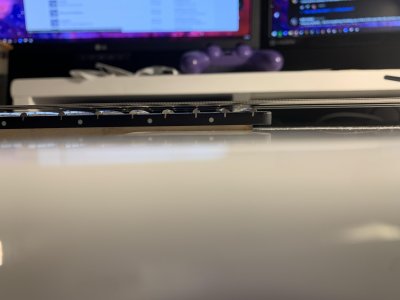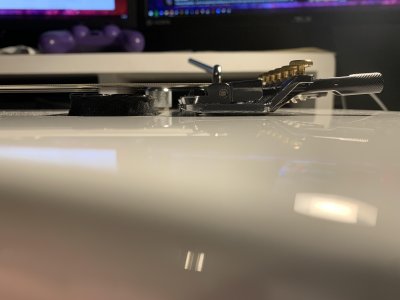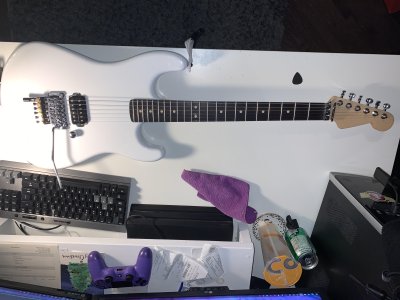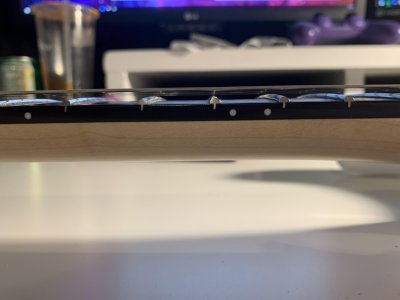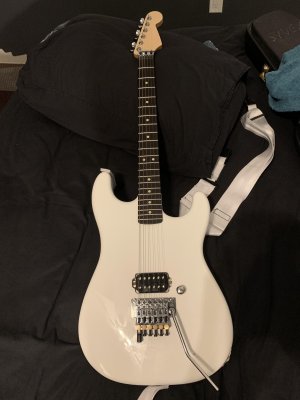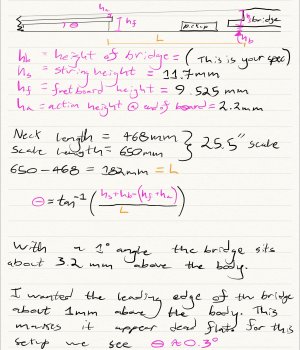bruzanhd
Senior Member
- Messages
- 217
The goal for this build was to be a very 80s inspired single humbucker, with the #1 concern that it had a decked floyd (resting against the body with no pull-up). I wanted to document this mostly for the sake of the floyd setup because hopefully if anyone else runs into this issue then they won't have to stress about it like I did. I will get into why this setup is such a challenge to achieve further into this thread. With that said the said here is the spec sheet:
Neck:
Construction
Modern
Shaft Wood
Quartersawn Maple
Fretboard Wood
Ebony
Unique Choice
No, Warmoth can choose for me.
Nut Width
1-11/16" (43mm) - Modern Medium
Right / Left Handed
Right-Handed
Neck Back Profile
Standard Thin
Fretboard Radius
10" - 16" Compound
Number of Frets
22
Scallops
None
Binding
None
Fret Size & Material
SS6100 - Jumbo (Stainless)
Tuner Hole Size
Gotoh/Grover (13/32" - 11/32")
Inlay Shape
Standard Dots
Inlay Material
Cream
Side Dots
White Side Dots
String Nut
R4 Floyd Prep w/ Mounting Holes
Mounting Holes
Standard 4-Bolt
Neck Heel Shape
Strat® Shape
Finish
Clear Satin Nitro (Maple/Non-Maple)
Body:
Construction
Solid
Core Wood
Alder
Lam Top Wood
No Lam Top
Right / Left Handed
Right-Handed
Control Cavity
Rear Rout
Neck Pickup Rout
None
Middle Pickup Rout
None
Bridge Pickup Rout
Humbucker (Wood Mount)
Controls
Volume 1
Jack Rout
7/8" (22mm) Side Jack Hole
Bridge Rout Type
Tremolo
Bridge Rout
Floyd Rose (Angled Pocket)
Would you like Warmoth to install the bridge studs?
No
Mounting Holes
Standard 4-Bolt
Neck Pocket Shape
Strat®
Body Contours
Forearm Contour, Tummy Cut
Battery Box
None
Paint Category
Solid
Top Color
Alpine White
Back Color
Alpine White
Satin or Gloss
Gloss
Hardware:
Gotoh tuners
Floyd rose 1984 reissue
Duncan JB with alnico 2 swap
500k CTS pot
D-tuna
Now, the setup. By default, the non recessed floyd comes with an angled neck pocket. The angle they use is 1deg. With these parameters, your bridge will float ~4mm above the body. No good. In order to prevent this issue you could specially order your body with a non angled neck pocket, but a) I did not know that was possible at the time of order, and b) you will absolutely have to shim the neck for this, (albeit the angle is very small at roughly 0.20-0.35deg. Since I already had the 1deg angle, I decided to reduce the angle. There is a number of ways you can do this; router, hand plan, sand paper, dremel, chisels. Whatever you are most confident with is best. I chose sandpaper and used a very wide chisel to act as a plane to nock down high spots at the end of the sanding process.
Procedure:
First you should have a rough idea of how much material you are actually going to remove. Simple trigonometry will help you make this estimate.
Neck pocket length (heel side to headstock side) = 76.2mm
Depending on your body wood, different grits of sandpaper may be better or worse. Harder woods will benefit from a grittier paper, simply because it wont take you as long this way. Since my body was swamp ash which is a harder wood, I used 80 grit paper and that worked very well. With this method it will take a serious amount of elbow grease to actually make any noticeable change in angle. In this regard this method is safest since it takes a lot of time to make even minute changes to neck angle.
Use a good straight edge and check for high and low spots frequently. Use pencil graphite to lightly shade all high spots and then lower them with the sand paper,again this will take time and you should ideally check the neck to body fit quite frequently. When checking the neck angle you must check under full tension with the neck bolted on properly. Since the neck screws will actually compress the wood a very small amount (<0.6mm) full tension is important. After all was said and done I estimate my neck angle to be in the neighborhood of 0.23-0.33deg which is what I expected based on my trigonometry. I have included a picture where I derive this numbers. (please note that the measurements are only rough, since these numbers are so small, getting a perfect measurement is not realistic.)
If you are a really talented builder, a flat neck pocket with a microtilt adjustment would actually be the perfect way to build a guitar like this.
Better pictures will come when I can borrow a camera
Neck:
Construction
Modern
Shaft Wood
Quartersawn Maple
Fretboard Wood
Ebony
Unique Choice
No, Warmoth can choose for me.
Nut Width
1-11/16" (43mm) - Modern Medium
Right / Left Handed
Right-Handed
Neck Back Profile
Standard Thin
Fretboard Radius
10" - 16" Compound
Number of Frets
22
Scallops
None
Binding
None
Fret Size & Material
SS6100 - Jumbo (Stainless)
Tuner Hole Size
Gotoh/Grover (13/32" - 11/32")
Inlay Shape
Standard Dots
Inlay Material
Cream
Side Dots
White Side Dots
String Nut
R4 Floyd Prep w/ Mounting Holes
Mounting Holes
Standard 4-Bolt
Neck Heel Shape
Strat® Shape
Finish
Clear Satin Nitro (Maple/Non-Maple)
Body:
Construction
Solid
Core Wood
Alder
Lam Top Wood
No Lam Top
Right / Left Handed
Right-Handed
Control Cavity
Rear Rout
Neck Pickup Rout
None
Middle Pickup Rout
None
Bridge Pickup Rout
Humbucker (Wood Mount)
Controls
Volume 1
Jack Rout
7/8" (22mm) Side Jack Hole
Bridge Rout Type
Tremolo
Bridge Rout
Floyd Rose (Angled Pocket)
Would you like Warmoth to install the bridge studs?
No
Mounting Holes
Standard 4-Bolt
Neck Pocket Shape
Strat®
Body Contours
Forearm Contour, Tummy Cut
Battery Box
None
Paint Category
Solid
Top Color
Alpine White
Back Color
Alpine White
Satin or Gloss
Gloss
Hardware:
Gotoh tuners
Floyd rose 1984 reissue
Duncan JB with alnico 2 swap
500k CTS pot
D-tuna
Now, the setup. By default, the non recessed floyd comes with an angled neck pocket. The angle they use is 1deg. With these parameters, your bridge will float ~4mm above the body. No good. In order to prevent this issue you could specially order your body with a non angled neck pocket, but a) I did not know that was possible at the time of order, and b) you will absolutely have to shim the neck for this, (albeit the angle is very small at roughly 0.20-0.35deg. Since I already had the 1deg angle, I decided to reduce the angle. There is a number of ways you can do this; router, hand plan, sand paper, dremel, chisels. Whatever you are most confident with is best. I chose sandpaper and used a very wide chisel to act as a plane to nock down high spots at the end of the sanding process.
Procedure:
First you should have a rough idea of how much material you are actually going to remove. Simple trigonometry will help you make this estimate.
Neck pocket length (heel side to headstock side) = 76.2mm
Depending on your body wood, different grits of sandpaper may be better or worse. Harder woods will benefit from a grittier paper, simply because it wont take you as long this way. Since my body was swamp ash which is a harder wood, I used 80 grit paper and that worked very well. With this method it will take a serious amount of elbow grease to actually make any noticeable change in angle. In this regard this method is safest since it takes a lot of time to make even minute changes to neck angle.
Use a good straight edge and check for high and low spots frequently. Use pencil graphite to lightly shade all high spots and then lower them with the sand paper,again this will take time and you should ideally check the neck to body fit quite frequently. When checking the neck angle you must check under full tension with the neck bolted on properly. Since the neck screws will actually compress the wood a very small amount (<0.6mm) full tension is important. After all was said and done I estimate my neck angle to be in the neighborhood of 0.23-0.33deg which is what I expected based on my trigonometry. I have included a picture where I derive this numbers. (please note that the measurements are only rough, since these numbers are so small, getting a perfect measurement is not realistic.)
If you are a really talented builder, a flat neck pocket with a microtilt adjustment would actually be the perfect way to build a guitar like this.
Better pictures will come when I can borrow a camera



